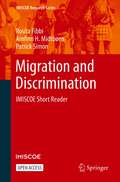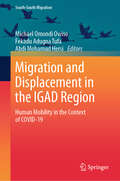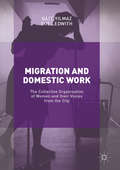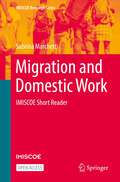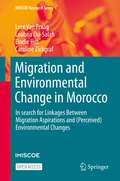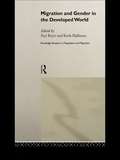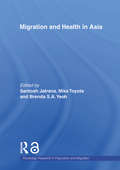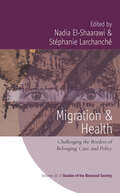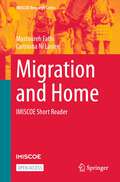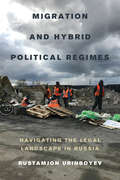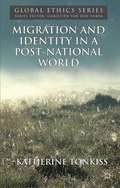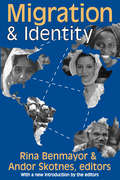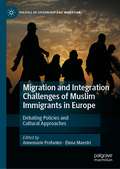- Table View
- List View
Migration and Diaspora in Modern Asia
by Sunil S. AmrithMigration is at the heart of Asian history. For centuries migrants have tracked the routes and seas of their ancestors - merchants, pilgrims, soldiers and sailors - along the Silk Road and across the Indian Ocean and the China Sea. Over the last 150 years, however, migration within Asia and beyond has been greater than at any other time in history. Sunil S. Amrith's engaging and deeply informative book crosses a vast terrain, from the Middle East to India and China, tracing the history of modern migration. Animated by the voices of Asian migrants, it tells the stories of those forced to flee from war and revolution, and those who left their homes and their families in search of a better life. These stories of Asian diasporas can be joyful or poignant, but they all speak of an engagement with new landscapes and new peoples.
Migration and Discrimination: IMISCOE Short Reader (IMISCOE Research Series)
by Patrick Simon Rosita Fibbi Arnfinn H. MidtbøenThis open access short reader provides a state of the art overview of the discrimination research field, with particular focus on discrimination against immigrants and their descendants. It covers the ways in which discrimination is defined and conceptualized, how it is measured, how it may be theorized and explained, and how it might be combated by legal and policy means. The book also presents empirical results from studies of discrimination across the world to show the magnitude of the problem and the difficulties of comparison across national borders. The concluding chapter engages in a critical discussion of the relationship between discrimination and integration as well as pointing out promising directions for future studies. As such this short reader is a valuable read to undergraduate students, as well as graduate students, scholars, policy makers and the general public.
Migration and Displacement in the IGAD Region: Human Mobility in the Context of COVID-19 (International Perspectives on Migration)
by Michael Omondi Owiso Fekadu Adugna Tufa Abdi Mohamud HersiThis book delves into the dynamics of human mobility and migration in the Intergovernmental Authority on Development (IGAD) region during the COVID-19 pandemic. It uses empirical sources from extensive fieldwork in the region to assess the impact of COVID-19 on conflict-induced internally displaced persons (IDPs), vulnerable and disadvantaged groups, the response of the government and IDPs coping mechanisms. It traces migration governance from regional and national perspectives and shares the opportunities and challenges in the region. The book presents the lessons learned and shares a way forward for the region during future pandemics. Chapters cover topics such as the protection of migrant workers’ rights, livelihoods of cross-border traders and communities and the gender dimension of COVID-19 impacts. It is a valuable read for students, policymakers, policy advisors, academics and all those interested in studies on migration and migration-related diversities.
Migration and Disruptions: Toward a Unifying Theory of Ancient and Contemporary Migrations
by Takeyuki Tsuda Brenda J. Baker“Artfully integrates scholarship on both past and present migration. With its thematic focus on disruption, this volume develops unprecedented nuance in the treatment of migration.”—Graciela S. Cabana, coeditor of Rethinking Anthropological Perspectives on Migration “A significant contribution to the social sciences in general and a future staple for archaeologists and anthropologists. Migration and Disruptions demonstrates the importance of collaboration and constructive dialogues between the traditional subfields composing the umbrella title of anthropology.”—Stephen A. Brighton, author of Historical Archaeology of the Irish Diaspora: A Transnational Approach Migration has always been a fundamental human activity, yet little collaboration exists between scientists and social scientists examining how it has shaped past and contemporary societies. This innovative volume brings together sociocultural anthropologists, archaeologists, bioarchaeologists, ethnographers, paleopathologists, and others to develop a unifying theory of migration. The contributors relate past movements, including the Anglo-Saxon settlement of Britain and the Islamic conquest of Andalucía, to present-day events, such as those in northern Ethiopia or at the U.S.-Mexico border. They examine the extent to which environmental and social disruptions have been a cause of migration over time and how these migratory flows have in turn led to disruptive consequences for the receiving societies. The observed cycles of social disruption, resettlement, and its consequences offer a new perspective on how human migration has shaped the social, economic, political, and environmental landscapes of societies from prehistory to today. Contributors:Brenda J. Baker | Christopher S. Beekman | George L. Cowgill | Jason De Leon | James F. Eder | Anna Forringer-Beal | Cameron Gokee | Catherine Hills | Kelly J. Knudson | Patrick Manning | Jonathan Maupin | Lisa Meierotto | James Morrissey | Rachel E. Scott | Christina Torres-Rouff | Takeyuki (Gaku) Tsuda | Sonia Zakrzewski
Migration and Domestic Space: Ethnographies of Home in the Making (IMISCOE Research Series)
by Paolo Boccagni Sara BonfantiThis open access book provides insight into the domestic space of people with an immigrant or refugee background. It selects and compares a whole spectrum of dwelling conditions with ethnographic material covering a variety of national backgrounds – Latin America, North and West Africa, Eastern Europe, South Asia – and an equally broad range of housing, household and legal arrangements. It provides a fine-grained understanding of migrants’ lived experience of their domestic space and shows the critical significance of the lived space of a house as a microcosm of societal constellations of identities, values and inequalities. The book enhances the connection between migration studies and research into housing, social reproduction, domesticity and material culture and provides an interesting read to scholars in migration studies, policy makers and practitioners with a remit in local housing and integration policies.“This wonderful edited collection extends our understanding of migration not only into the confines of the domestic space but also into the territory of the ethnographer. What does it mean to be a guest in a migrant home? This collection of chapters traverses this question in diverse settings and circumstances of homemaking […]. Boccagni and Bonfanti have skilfully created an intricate lace of ethnographic accounts that provides a nuanced understanding of the built environments where migrants live, how they relate to their homes and how this is articulated in their attitudes toward majority society. The chapters, each on its own and together as a collection, advance our understanding of the researcher being a guest in the migrant home, just like the migrant being a guest in the host country. This complexity of ethnography and positionality makes this edited book an essential reading for migration scholars and ethnographers alike!” Iris Levin, Lecturer in Urban Studies, RMIT University, Melbourne, Australia “This book demonstrates how ethnographies of home and dwelling can bear on the study of migration and its manifestation in domestic space. Entering someone’s home as a researcher challenges our ethical registers: the researcher moves between being a stranger and a guest. The authors point to the dilemmas researchers encounter in intimate settings and how they might be resolved. A valuable and timely book for researchers on dwelling, home and movement.” Cathrine Brun, Professor of Human Geography, Centre for Lebanese Studies, Oxford, UK "This excellent collection delves into the relationship between migration, domesticity, and material culture. It is ethnographically rich and impressively varied in its geographical scope, with insights that will prove extremely useful to scholars and practitioners alike. The great strength of the volume lies in the fascinating diversity, granular detail and methodological care of the contributions, with authors deploying concepts and arguments that prepare a great deal of fertile ground for future work." Tom Scott-Smith, Associate Professor of Refugee Studies and Forced Migration, University of Oxford “This insightful collection departs from the simple yet significant question of roles: What happens when the researcher/participant relationship, becomes guest/host instead? By seeing and interpreting domestic spaces as ethnographic field sites, the contributions shed light on refugees’ and other migrants’ lived experiences of home and housing. Drawing on empirical evidence from diverse types of homes, across geographic locations, Migration and domestic space: Ethnographies of home in the making offers valuable and fresh perspective, encouraging new connections between material and emotional, public and private, in migration research.” Marta Bivand Erdal, Research Professor in Migration studies, Peace Research Institute Oslo (PRIO).</
Migration and Domestic Work
by Gaye Yilmaz Sue LedwithWith female migrants dominating low paid and ever-expanding domestic work worldwide, this book brings together the voices of 120 migrating women of 28 national identities and 10 different religious affiliations. Together they tell how patriarchal and religious gender codes in the family and at work shape their new lives in London, Berlin and Istanbul. Through their own accounts, the study explores the intersecting multiple and gendered identities women carry from their home countries and how these are reshaped, challenged, changed, or not, as they encounter different structures, traditions and cultural codes in their new countries. With women's propensity for collective organising, whether via community, social movements or trade unions as a central theme, the authors also bring together issues of migration, work and identity with trade union and community organizing. Migration and Domestic Work is an important source for scholars and practitioners in each of these fields.
Migration and Domestic Work: A European Perspective on a Global Theme (Studies in Migration and Diaspora)
by Helma LutzDomestic work has become highly relevant on a local and global scale. Until a decade ago, domestic workers were rare in European households; today they can be found working for middle-class families and single people, for double or single parents as well as for the elderly. Performing the three C's - cleaning, caring and cooking - domestic workers offer their woman power on a global market which Europe has become part of. This global market is now considered the largest labour market for women world wide and it has triggered the feminization of migration. This volume brings together contributions by European and US based researchers to look at the connection between migration and domestic work on an empirical and theoretical level. The contributors elaborate on the phenomenon of 'domestic work' in late modern societies by discussing different methodological and theoretical approaches in an interdisciplinary setting. The volume also looks at the gendered aspects of domestic work; it asks why the re-introduction of domestic workers in European households has become so popular and will argue that this phenomenon is challenging gender theories. This is a timely book and will be of interest to academics and students in the fields of migration, gender and European studies.
Migration and Domestic Work: IMISCOE Short Reader (IMISCOE Research Series)
by Sabrina MarchettiThis open access short reader offers a systematic overview of the scholarly debate on the experiences of migrant domestic workers at a global level, in the past as well as in present time. It tackles the nexus between migration and domestic work with a multi-layered approach. The book looks into the issue of (paid) domestic work in migratory contexts by investigating the feminization of migration, thereby considering the larger framework within which this specific phenomenon takes place. The author explains notions such as the “international division of reproductive labor” or “global care chains” which emphasize the inequality in the way care and domestic tasks are distributed today between middle-class women in receiving nations and migrant domestic workers. Moreover, the book shows how women migrating to work in the domestic work and private care sector are facing a complex landscape of migration and labor regulations that are extremely difficult to navigate. At the same time, this issue also addresses employers’ households who cannot find appropriate or affordable care among declining welfare states and national workers reluctant to take the job, whilst legal regulations make difficult to hire a domestic worker who is a third country national. As such this book offers an interesting read to academics, policy makers and all those working in the field.
Migration and Environmental Change in Morocco: In search for Linkages Between Migration Aspirations and (Perceived) Environmental Changes (IMISCOE Research Series)
by Caroline Zickgraf Lore Van Praag Loubna Ou-Salah Elodie HutThis open access book studies the migration aspirations and trajectories of people living in two regions in Morocco that are highly affected by environmental change or emigration, namely Tangier and Tinghir, as well as the migration trajectories of immigrants coming from these regions currently living in Belgium. This book departs from the development of a new theoretical framework on the relationship between environmental changes and migration that can be applied to the Moroccan case. Qualitative research conducted in both countries demonstrate how the interplay between migration and environmental factors is not as straightforward as it seems, due to its wider social, political, economic, demographic and environmental context. Findings show how existing cultures of migration, remittances, views on nature and discourses on climate change create distinct abilities, capacities and aspirations to migrate due to environmental changes. The results illustrate how migration and environmental factors evolve gradually and mutually influence each other. In doing so, this book offers new insights in the ways migration can be seen as an adaptation strategy to deal with environmental change in Morocco.
Migration and Families in East and North Europe: Translocal Lifelines (Studies in Migration and Diaspora)
by Laura Assmuth Marina Hakkarainen Pihla Maria Siim Marit AureThis book explores the phenomenon of familyhood across borders, examining the experience of translocal familyhood and the manner in which lifelines in and between countries are formed when individual family members spend long periods away from home. Drawing on long-term ethnographic research, it considers the emotions, social relations, materialities and discourses that occur within family lives between Estonia, Finland, Latvia, Lithuania, Norway, Romania, Russia and Sweden. With attention to the ways in which gender, generation, class and geography create and reinforce inequalities, strengths and vulnerabilities within and between families, it combines ethnographic, descriptive work with shorter photography-based chapters in order to allow textual and visual methods to complement one another. As such, it will appeal to scholars of sociology, geography and anthropology with interests in migration, transnationalism and the sociology of the family.
Migration and Gender in the Developed World (Routledge Research in Population and Migration)
by Paul Boyle Keith HalfacreeThe subject of migration has traditionally been analysed through the lens of economic factors. The importance of adopting a gender sensitive perspective to academic work is now generally appreciated. Migration and Gender in the Developed World contains chapters from a diverse range of leading contributors who apply such a perspective to the study of migration in the countries of the developed world. Each chapter demonstrates how migration is highly gendered, with the experiences of women and men often varying markedly in different migration situations. The volume covers a wide range of migration issues and draws out the importance of gender issues in each area, including: dual career households regional migration patterns emigration from Ireland and Hong Kong elderly migration the migration decision-making process and the costs and benefits attached to migration Approaching the subject from a variety of academic traditions including Geography, Sociology and Social Policy, the volume combines both quantitative analysis of factual data and qualitative analysis of interview material to demonstrate the importance of studying migration through gender sensitive eyes.
Migration and Health
by Marc B. Schenker Xóchitl Castañeda Alfonso Rodriguez-LainzThe study of migrant populations poses unique challenges owing to the mobility of these groups, which may be further complicated by cultural, educational, and linguistic diversity as well as the legal status of their members. These barriers limit the usefulness of both traditional survey sampling methods and routine public health surveillance systems. Since nearly 1 in 7 people in the world is a migrant, appropriate methodological approaches must be designed and implemented to capture health data from populations. This effort is particularly important because migrant populations, in comparison to other populations, typically suffer disparities related to limited access to health care, greater exposure to infectious diseases, more occupational injuries, and fewer positive outcomes for mental health and other health conditions. This path-breaking handbook is the first to engage with the many unique issues that arise in the study of migrant communities. It offers a comprehensive description of quantitative and qualitative methodologies useful in work with migrant populations. By providing information and practical tools, the editors fill existing gaps in research methods and enhance opportunities to address the health and social disparities migrant populations face in the United States and around the world.
Migration and Health
by Sandro Galea Muhammad H. Zaman Catherine K. EttmanA new introduction to a timeless dynamic: how the movement of humans affects health everywhere. International migrants compose more than three percent of the world’s population, and internal migrants—those migrating within countries—are more than triple that number. Population migration has long been, and remains today, one of the central demographic shifts shaping the world around us. The world’s history—and its health—is shaped and colored by stories of migration patterns, the policies and political events that drive these movements, and narratives of individual migrants. Migration and Health offers the most expansive framework to date for understanding and reckoning with human migration’s implications for public health and its determinants. It interrogates this complex relationship by considering not only the welfare of migrants, but also that of the source, destination, and ensuing-generation populations. The result is an elevated, interdisciplinary resource for understanding what is known—and the considerable territory of what is not known—at an intersection that promises to grow in importance and influence as the century unfolds.
Migration and Health
by Sandro Galea Muhammad H. Zaman Catherine K. EttmanA new introduction to a timeless dynamic: how the movement of humans affects health everywhere. International migrants compose more than three percent of the world’s population, and internal migrants—those migrating within countries—are more than triple that number. Population migration has long been, and remains today, one of the central demographic shifts shaping the world around us. The world’s history—and its health—is shaped and colored by stories of migration patterns, the policies and political events that drive these movements, and narratives of individual migrants. Migration and Health offers the most expansive framework to date for understanding and reckoning with human migration’s implications for public health and its determinants. It interrogates this complex relationship by considering not only the welfare of migrants, but also that of the source, destination, and ensuing-generation populations. The result is an elevated, interdisciplinary resource for understanding what is known—and the considerable territory of what is not known—at an intersection that promises to grow in importance and influence as the century unfolds.
Migration and Health
by Sandro Galea Muhammad H. Zaman Catherine K. EttmanA new introduction to a timeless dynamic: how the movement of humans affects health everywhere. International migrants compose more than three percent of the world’s population, and internal migrants—those migrating within countries—are more than triple that number. Population migration has long been, and remains today, one of the central demographic shifts shaping the world around us. The world’s history—and its health—is shaped and colored by stories of migration patterns, the policies and political events that drive these movements, and narratives of individual migrants. Migration and Health offers the most expansive framework to date for understanding and reckoning with human migration’s implications for public health and its determinants. It interrogates this complex relationship by considering not only the welfare of migrants, but also that of the source, destination, and ensuing-generation populations. The result is an elevated, interdisciplinary resource for understanding what is known—and the considerable territory of what is not known—at an intersection that promises to grow in importance and influence as the century unfolds.
Migration and Health in Asia (Routledge Research in Population and Migration #10)
by Mika Toyota Brenda S.A. Yeoh Santosh JatranaThe processes of migration and health are inextricably linked in complex ways, with migration impacting on the mental and physical health of individuals and communities. Health itself can be a motivation for moving or a reason for staying, and migration can have implications on the health of those who move, those who are left behind, and the communities that receive migrants. This volume brings together some of the increasing number of researchers who are studying health and migration in Asia - a continent which is a major exporter and importer of human resources. Using both quantitative and qualitative approaches, the essays included in this work investigate the interdisciplinary issues of health and health-related behaviours in the field of migration. Comprehensive and scholarly, Migration and Health in Asia also covers major themes such as the pandemics of HIV/AIDS and SARS, differential access to health and civil society for migrants, and the health of the populations who are left behind.
Migration and Health: Challenging the Borders of Belonging, Care, and Policy (Studies of the Biosocial Society #10)
by Nadia El-Shaarawi and Stéphanie LarchanchéDespite the centrality of migration in our contemporary world, scholarship on mobility and health frequently separates migrants according to legal status, country of origin, destination, or health concern. Yet people on the move and health systems face challenges and opportunities that transcend these boundaries, including border fortification, neoliberal agendas, and climate change. This volume explores these epistemic borders, recognizing the necessity of a new conversation about migration and health. Each of the empirically grounded chapters introduces readers to pressing questions of migration and health in diverse social, political, and geographical settings.
Migration and Home: IMISCOE Short Reader (IMISCOE Research Series)
by Mastoureh Fathi Caitríona Ní LaoireThis open access short reader offers an intersectional perspective on the meaning of home in migration. The book provides a pathway through existing scholarship on home and migration, exploring how intersectional power relations and transnational migration regimes are felt, experienced, lived and navigated by migrants, who are differently positioned, in the making and imagining of home. The meanings associated with home are composed of the interrelation of places, spaces, people, social relations, materialities, emotions and temporalities. These multiple aspects highlight the complexities inherent in the idea of home, which come to the fore particularly when one moves location. Migration and Home explores these issues by focusing on specific key aspects of home in migration: home and gender; home and age; home and materiality; and home and migration status, class and race. It proposes the concept of structural im/possibilities as a framework for understanding the power relations and structures that shape where, when and for whom home in migration is more, or less, possible.
Migration and Hybrid Political Regimes: Navigating the Legal Landscape in Russia
by Rustamjon UrinboyevA free open access ebook is available upon publication. Learn more at www.luminosoa.org. While migration has become an all-important topic of discussion around the globe, mainstream literature on migrants' legal adaptation and integration has focused on case studies of immigrant communities in Western-style democracies. We know relatively little about how migrants adapt to a new legal environment in the ever-growing hybrid political regimes that are neither clearly democratic nor conventionally authoritarian. This book takes up the case of Russia—an archetypal hybrid political regime and the third largest recipients of migrants worldwide—and investigates how Central Asian migrant workers produce new forms of informal governance and legal order. Migrants use the opportunities provided by a weak rule-of-law and a corrupt political system to navigate the repressive legal landscape and to negotiate—using informal channels—access to employment and other opportunities that are hard to obtain through the official legal framework of their host country. This lively ethnography presents new theoretical perspectives for studying immigrant legal incorporation in similar political contexts.
Migration and Identity in Central Asia: The Uzbek Experience (Central Asia Research Forum)
by Rano TuraevaThis book is an ethnographic and sociolinguistic study of Uzbek migrants in the capital city of Uzbekistan. The ethnographic details of the book represent post-Soviet urban realities on the ground where various forms of belonging clash and kinship ties are reinforced within social safety networks. Theoretically, it challenges the existing theories of identity and identification which often considered the relations between 'We and Them' taking the 'We' for granted. The book offers in-depth insights into the communication strategies of migrants, the formation of collective consciousness and the relations within the 'We' domain. Constructed around contradictions regarding Uzbek identity and how various groups relate to one another as different ethnic groups, the theoretical argument of the book is built through such methods and analytical tools as strategic rhetoric and discourse analysis, communication and identity theories, and the analysis of power and dependence. The book will be of interest to students and scholars of Central Asian Studies, Migration Studies, and Central Asian Culture and Society.
Migration and Identity in a Post-National World
by Katherine TonkissKatherine Tonkiss offers a succinct account of constitutional patriotism theory, specifically arguing that it involves a commitment to free migration. She draws on qualitative research to explore the implications of this claim for the dynamics of post-national identity and belonging in local communities.
Migration and Identity through Creative Writing: StOries: Strangers to Ourselves (IMISCOE Research Series)
by Anna Triandafyllidou Alka KumarThis open access book brings together storytelling and self-narrative, creative writing and narrative enquiry to explore a variety of topics in migration from an experiential lens. The volume is hybrid and multi-genre as it contains both scholarly chapters grounded in academic perspectives, as well as personal essays and creative non-fiction. In addition to critical reflections on key migration topics and concepts – like, identity and diversity, integration and agency, transnationalism and return – the scholarly chapters also propose a particular methodology for ‘workshopping’ migration narratives, and writing about (personal) lived experiences through iterations of scientific reflection, narrative enquiry, and creative imagination. The book explores the potential of a new conceptual paradigm and methodological process to learn more, and also `differently,’ about the migration experience. Finally, this volume asks a bigger question too – how do we define the boundaries of research; is it possible to entirely separate the spatial, temporal and methodological parameters in which projects are developed and pursued; and how can the specifics of these multiple contexts contribute to shaping the knowledge being produced?
Migration and Identity: Volume Iii: Migration And Identity (International Yearbook Of Oral History And Life Stories Ser. #Vol. 3)
by Rina Benmayor Andor SkotnoesThe theme of Migration and Identity is of special concern at a time both of massive worldwide migration and of apparently intensifying national, ethnic, and racial conflicts. Problems of migration and the resulting reconfigurations of social identity are fundamental issues for the twenty-first century. This volume spans the whole complex global web of migratory patterns with contributions linking Africa, Asia, Australia, Europe, North and South America, without losing the particularities of local and personal experience.This paperback edition in the Memory and Narrative series explores these issues and the sustaining or abandoning of memory and identity as people move between fundamentally different cultures, in a number of recent social settings, from a number of methodological perspectives. These focused "case studies" offer glimpses into the interior migration experiences, into the processes of constructing and reconstructing identity without forgetting that, both theoretically and empirically, the problem of identity is complex and multifaceted. All of the essays rely heavily on oral history and personal testimony, highlighting the experience of individuals and small groups, without ignoring the tension that exists between the local and the global.Memories of oppression or totalitarianism are one of the driving forces behind some of these migrations; and the transmission of memories and myths between family generations is one of the ways in which migrations are interpreted. In looking both backward and forward, Migration and Identity, offers an acute view of migratory patterns and their impact on the newcomers and the local cultures. It will be of interest to cultural and oral historians and researchers of concerned with migration and integration.
Migration and Inequality
by Mirna SafiIn a world of increasingly heated political debates on migration, relentlessly caught up in questions of security, humanitarian crisis, and cultural “problems,” this book radically shifts the focus to address migration through the lens of inequality. Taking an innovative approach, Mirna Safi offers a fresh perspective on how migration is embedded in the elementary mechanisms that shape the landscape of inequality. She sketches out three distinct channels which lead to unequal outcomes for different migrating and non-migrating groups: the global division of labor; the production of legal and administrative categories; and the reconfiguration of symbolic ethnoracial groups. Respectively, these channels categorize migrants as “type of workers,” “type of citizens,” and “type of humans.” Examining this intersection across the U.S. and Europe, she shows how studying international migration together with inequality can challenge nationally established paradigms of social justice. This timely book will be essential reading for all students and researchers interested in the sociology and politics of migration, ethnic and racial studies, and social inequality and stratification.
Migration and Integration Challenges of Muslim Immigrants in Europe: Debating Policies and Cultural Approaches (Politics of Citizenship and Migration)
by Elena Maestri Annemarie ProfanterAs the impetus of globalization continues to gather pace, more and more people leave their homes pursuing dreams of a better life for themselves and their families. Muslim immigrants converging on Europe from widely divergent communities scattered throughout North Africa, the Middle East and South-East Asia, represent a great variety of local cultures and traditions. Trans-Mediterranean networks form the basis of migration routes and are key factors in the destinations of these migrants and in the overall process of immigration, be this towards Europe or other Muslim countries. South-North fluxes intertwine with South-South fluxes, among which the Gulf Arab countries stand out as a prime destination, not only for low-skilled labour. Different situations emerge, within a variegated discourse on co-existence, integration, assimilation and the preservation of identity. The adoption of this transnational dimension incorporating both destination, and points of origin, enables the investigation of migration to move beyond a purely Eurocentric approach. Thus, different national patterns are analyzed with a focus on a number of significant case-studies. By debating policies and cultural approaches the aim is to add innovative scholarship to the challenge of integration. Cross-cultural pluralism on the part of the nation states comprising the European Union is one avenue for moving the dialogue between different cultural frameworks towards a more compatible form.

